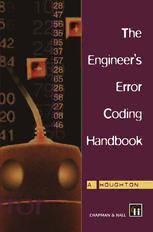
The Engineer’s Error Coding Handbook PDF
Preview The Engineer’s Error Coding Handbook
The Engineer's Error Coding Handbook JOIN US ON THE INTERNET VIA WWW, GOPHER, FTP OR EMAIL: WWW: http://www.thomson.com GOPHER: gopher.thomson.com (T\® As ervice of I(!)P FTP: ftp.thomson.com EMAIL: [email protected] The Engineer's Error Coding Handbook A.D. Houghton Department of Electronic and Electrical Engineering The University of Sheffield Sheffield UK CHAPMAN & HALL London· Weinheim . New York· Tokyo· Melbourne· Madras Published by Chapinan & Hall, 2-6 Boundary Row, London SE18HN, UK Chapman & Hall, 2-6 Boundary Row, London SEI 8HN, UK Chapman & Hall GmbH, Pappelallee 3,69469 Weinheim, Germany Chapman & Hall USA, 115 Fifth Avenue, New York, NY 10003, USA Chapman & Hall Japan, ITP-Japan, Kyowa Building, 3F, 2-2-1 Hirakawacho, Chiyoda-ku, Tokyo 102, Japan Chapman & Hall Australia, 102 Dodds Street, South Melbourne, Victoria 3205, Australia Chapman & Hall India, R. Seshadri, 32 Second Main Road, CIT East, Madras 600 035, India First edition 1997 © 1997 A.D. Houghton ISBN -13: 978-0-412-79070-6 e-ISBN -13 :978-1-4613-0447-0 DOl: 10.1007/978-1-4613-0447-0 Apart from any fair dealing for the purposes of research or private study, or criticism or review, as permitted under the UK Copyright Designs and Patents Act, 1988, this publication may not be reproduced, stored, or transmitted, in any form or by any means, without the prior permission in writing of the publishers, or in the case of reprographic reproduction only in accordance with the terms of the licences issued by the Copyright Licensing Agency in the UK, or in accordance with the terms of licences issued by the appropriate Reproduction Rights Organization outside the UK. Enquiries concerning reproduction outside the terms stated here should be sent to the publishers at the London address printed on this page. The publisher makes no representation, express or implied, with regard to the accuracy of the information contained in this book and cannot accept any legal responsibility or liability for any errors or omissions that may be made. A catalogue record for this book is available from the British Library 8 Printed on permanent acid-free text paper, manufactured in accordance with ANSIINISO Z39.48-1992 and ANSIINISO Z39.48-1984 (Permanence of Paper). Contents Preface xi Glossary of terms xiii PART ONE ERROR DETECTION 1 Introduction 3 1.1 Redundancy 3 1.2 Orthogonality 4 1.3 Data packaging 5 1.4 Summary 6 2 Parity checking 7 2.1 The horizontal and vertical parity check 7 2.2 Generating the parity bit 8 2.3 Discussion 11 3 Cyclic redundancy checking 12 3.1 Ground rules and terms 12 3.2 An overview of the CRC 13 3.3 The generator polynomial 14 3.4 Finite fields 15 3.5 Longhand calculation of the CRC 18 3.6 Performance 20 3.7 Hardware implementation 21 3.8 Discussion 24 PART TWO ERROR CORRECTION, AN INTRODUCTION 25 4 Hamming codes 27 4.1 Correcting a single bit 29 4.2 Extending the message size 31 4.3 Discussion 34 vi Contents 5 Error correction using the CRC 35 5.1 Locating single-bit errors 35 5.2 A hardware error locator 37 5.3 Multiple-bit errors 39 5.4 Expurgated codes 40 5.5 Soft decision decoding 41 5.6 Discussion 43 PART THREE TIME DOMAIN REED-SOLOMON CODING 45 6 Correcting errors in the time domain 47 6.1 Manipulating fInite fIeld elements 47 6.2 Introduction to the time domain 57 6.3 Calculating check symbols for one error 57 6.4 Example of a one-symbol error correction 59 6.5 Discussion 61 7 Correcting two symbols 62 7.1 Correcting by erasure 62 7.2 Finding check symbols for two errors 63 7.3 Example of a two-symbol error correction 69 7.4 Discussion 72 PART FOUR FREQUENCY DOMAIN REED-SOLOMON CODING 75 8 Frequency domain coding 77 8.1 Calculating a Fourier transform 77 8.2 Using the frequency domain to encode a message 79 8.3 Correcting errors in the frequency domain 81 8.4 How does recursive extension work? 88 8.5 Correction limits 92 8.6 Summary of frequency domain coding 93 8.7 An example over GF(28) 95 8.8 Exceeding the error capacity of the code 100 8.9 Discussion 102 9 Mixed domain error coding 104 9.1 Advantages of time domain processing 104 Contents vii 9.2 Calculating the errors in the frequency domain 104 9.3 Finding the check symbols using matrix inversion 106 9.4 Finding the check symbols using the FFT 109 9.5 Discussion 112 PART FIVE PACKAGING THE DATA 113 10 Block-interleaving 115 10.1 Discussion 120 11 Multi-dimensional data structures 121 11.1 Multi-dimensional time domain coding 121 11.2 Two-dimensional frequency domain coding 125 11.3 Punctured codes 132 11.4 Discussion 133 12 Convolutional coding 135 12.1 Finding the correct path 138 12.2 Other convolutional coders 140 12.3 Discussion 141 12.4 Symbol-based convolutional coding 142 PART SIX PRACTICAL CONSIDERATIONS 153 13 Manipulating elements with hardware 155 13.1 Multiplying elements using XOR gates 155 13.2 A hardware time domain encoder/decoder 161 13.3 General hardware considerations 165 13.4 Bit error rates 168 14 Applications 172 14.1 Example application one 173 14.2 Example application two 176 14.3 Some real applications 179 14.4 Summary of ground covered 182 14.5 Bibliography 183 viii Contents PART SEVEN EXERCISES 185 15 Questions 187 15.1 Parity 187 15.2 Cyclic redundancy checking 188 15.3 Manipulating finite field elements 189 15.4 Convolutional coding 192 16 Solutions 194 16.1 Parity 194 16.2 Cyclic redundancy checking 195 16.3 Manipulating finite field elements 201 16.4 Convolutional coding 210 Appendix A Some primitive polynomials 212 Appendix B Solutions to some key equations 217 Appendix C Frequency domain example 221 Appendix D Time domain error correction in three dimensions 242 Appendix E Correcting two-dimensional data in the frequency domain 245 Appendix F Example of mixed domain error correction 249 Index 252 Dedicated to my parents Hugh and Hazel Houghton
